Extracting Key Drivers of Air Passenger’s Experience and Satisfaction through Online Review Analysis †
Abstract
1. Introduction
- Understanding the airline traveler experience based on the top frequency words concluded from the textual reviews on Skytrax (airlinequality.com);
- Conduct semantic network analysis based on airline traveler online reviews;
- Show the connectivity, segmentations, and differences of the top frequency words with visualization and convergence of iterated correlation;
- Investigate the factors that consist of airline traveler experience;
- Identify the relationship between airline traveler experience and satisfaction through linear regression analysis.
2. Literature Review
2.1. Airline Industry
2.2. Skytrax
- ✓
- Condition of park for airlines are: Aeroflot—6/7, Air Astana—6/7, Azerbaijan Airlines—5/7, Korean Air—7/7, Asiana Airlines—7/7.
- ✓
- Route network for airlines are: Aeroflot—59 countries and 176 cities, Air Astana—20 countries and 38 cities, Azerbaijan Airlines—23 countries and 47 cities, Korean Air—45 countries and 116 cities, Asiana Airlines—24 countries and 76 cities.
- ✓
- Frequency of flights of airlines are: Aeroflot—6/7, Air Astana—6/7, Azerbaijan Airlines—5/7, Korean Air—7/7, Asiana Airlines—7/7.
- ✓
- Safety ratings for airlines are: Aeroflot—6/7, Air Astana—5/7, Azerbaijan Airlines—6/7, Korean Air—7/7, Asiana Airlines—7/7.
- ✓
- Quality of service of airlines are: Aeroflot—4/5, Air Astana—4/5, Azerbaijan Airlines—4/5, Korean Air—4/5, Asiana Airlines—4/5.
- ✓
- Tariffs and price characteristics of airlines are: Aeroflot—4/5, Air Astana—4/5, Azerbaijan Airlines—4/5, Korean Air—4/5, Asiana Airlines—4/5.
- ✓
- Company image and marketing image for airlines are: Aeroflot—6/10, Air Astana—8/10, Azerbaijan Airlines—7/10, Korean Air—8/10, Asiana Airlines—8/10.
- ✓
- Land infrastructure for airlines are: Aeroflot—6/7, Air Astana—6/7, Azerbaijan Airlines—5/7, Korean Air—7/7, Asiana Airlines—7/7.
2.3. Online Customer Reviews
3. Materials and Methods
3.1. Qualitative Data Analysis
3.2. Quantitative Data Analysis
4. Results
4.1. Frequency Analysis
4.2. Semantic Network Analysis
4.3. Linear Regression Analysis
5. Discussion
6. Conclusions
Author Contributions
Funding
Conflicts of Interest
References
- Chen, L.; Li, Y.Q.; Liu, C.H. How airline service quality determines the quantity of repurchase intention-Mediate and moderate effects of brand quality and perceived value. J. Air Trans. Manag. 2019, 75, 185–197. [Google Scholar] [CrossRef]
- Aircraft Aerodynamics and Design Group Stanford University. The Airline Industry. Available online: http://adg.stanford.edu/aa241/intro/airlineindustry.html (accessed on 20 May 2020).
- Arjomandi, A.; Dakpo, K.H.; Seufert, J.H. Have Asian airlines caught up with European Airlines? A by-production efficiency analysis. Trans. Res. Part A Policy Prac. 2018, 116, 389–403. [Google Scholar] [CrossRef]
- Heriyanto, D.S.N.; Putro, Y.M. Challenges and opportunities of the establishment ASEAN open skies policy. Padjadjaran J. Law 2019, 6, 466–488. [Google Scholar]
- Belarmino, A.M.; Koh, Y. How E-WOM motivations vary by hotel review website. Int. J. Contemp. Hosp. Manag. 2018, 30, 2730–2751. [Google Scholar] [CrossRef]
- Rajaguru, R. Role of value for money and service quality on behavioural intention: A study of full service and low cost airlines. J. Air Trans. Manag. 2016, 53, 114–122. [Google Scholar] [CrossRef]
- Korean Tourism Organization. Russian Tourism Market Analysis. Available online: https://kto.visitkorea.or.kr/kor/notice/data/report/org/board/view.kto?id=306350&rnum=289 (accessed on 18 October 2020).
- Sampson, R.J. Great American City: Chicago and the Enduring Neighborhood Effect; University of Chicago Press: Chicago, IL, USA, 2012. [Google Scholar]
- Knorr, A. Big data, customer relationship and revenue management in the airline industry: What future role for frequent flyer programs? Rev. Integr. Bus. Econo. Res. 2019, 8, 38–51. [Google Scholar]
- Muturi, D.; Sagwe, J.; Namukasa, J. The influence of airline service quality on passenger satisfaction and loyalty. TQM J. 2013, 25, 520–532. [Google Scholar]
- Hausladen, I.; Schosser, M. Towards a maturity model for big data analytics in airline network planning. J. Air Trans. Manag. 2020, 82, 101721. [Google Scholar] [CrossRef]
- Brochado, A.; Rita, P.; Oliveira, C.; Oliveira, F. Airline passengers’ perceptions of service quality: Themes in online reviews. Inter. J. Contemp. Hosp. Manag. 2019, 31, 855–873. [Google Scholar] [CrossRef]
- Pérezgonzález, J.D.; Gilbey, A. Predicting Skytrax airport rankings from customer reviews. J. Airpt. Manag. 2011, 5, 335–339. [Google Scholar]
- Scotti, D.; Volta, N. Profitability change in the global airline industry. Trans. Res. Part E Log. Trans. Rev. 2017, 102, 1–12. [Google Scholar] [CrossRef]
- Amankwah-Amoah, J. Stepping up and stepping out of COVID-19: New challenges for environmental sustainability policies in the global airline industry. J. Clean. Product. 2020, 271, 123000. [Google Scholar] [CrossRef]
- Siering, M.; Deokar, A.V.; Janze, C. Disentangling consumer recommendations: Explaining and predicting airline recommendations based on online reviews. Decis. Support Syst. 2018, 107, 52–63. [Google Scholar] [CrossRef]
- Song, C.; Guo, J.; Zhuang, J. Analyzing passengers’ emotions following flight delays-a 2011–2019 case study on SKYTRAX comments. J. Air Trans. Manag. 2020, 89, 101903. [Google Scholar] [CrossRef]
- Adeniran, A.; Fadare, S.O. Relationship between passengers’ satisfaction and service quality in murtala muhammed international airport, Lagos, Nigeria. Int. J. Res. Ind. Eng. 2018, 7, 349–369. [Google Scholar]
- Jeong, E.Y. Analyze of Airlines Online-reviews: Focusing on Skytrax. J. Tour. Leis. Res. 2017, 2, 261–276. [Google Scholar]
- Yayla-Kullu, H.M.; Tansitpong, P. A critical evaluation of US airlines’ service quality performance: Lower costs vs. satisfied customers. J. Manag. Strategy 2013, 4, 1. [Google Scholar] [CrossRef]
- Lohmann, G.; Albers, S.; Koch, B.; Pavlovich, K. From hub to tourist destination–An explorative study of Singapore and Dubai’s aviation-based transformation. J. Air Transp. Manag. 2009, 15, 205–211. [Google Scholar] [CrossRef]
- Mason, K.J.; Morrison, W.G. Towards a means of consistently comparing airline business models with an application to the ‘low cost’ airline sector. Res. Transp. Econ. 2008, 24, 75–84. [Google Scholar] [CrossRef]
- Park, J.W.; Robertson, R.; Wu, C.L. The effects of individual dimensions of airline service quality: Findings from Australian domestic air passengers. J. Hosp. Tour. Manag. 2006, 13, 161–176. [Google Scholar] [CrossRef]
- Gillen, D.; Lall, A. Competitive advantage of low-cost carriers: Some implications for airports. J. Air Transp. Manag. 2004, 10, 41–50. [Google Scholar] [CrossRef]
- Kim, S.; Kandampully, J.; Bilgihan, A. The influence of eWOM communications: An application of online social network framework. Comput. Human Behav. 2018, 80, 243–254. [Google Scholar] [CrossRef]
- Bhandari, R.S.; Bansal, A. A study of characteristics of e-WoM affecting consumer’s social media opinion behavior. J. Indian Manag. Strategy 2019, 24, 33–43. [Google Scholar] [CrossRef]
- Kim, H.S.; Noh, Y. Elicitation of design factors through big data analysis of online customer reviews for washing machines. J. Mech. Sci. Technol. 2019, 33, 2785–2795. [Google Scholar] [CrossRef]
- Ban, H.J.; Kim, H.S. A study on the TripAdvisor review analysis of restaurant recognition in Busan 1: Especially concerning English reviews. Culi. Sci. Hosp. Res. 2019, 25, 1–11. [Google Scholar]
- Skytrax. World Airline Awards. Available online: http://www.worldairlineawards.com/ (accessed on 20 March 2019).
- Ban, H.J.; Kim, H.S. Understanding customer experience and satisfaction through airline passengers’ online review. Sustainability 2019, 11, 4066. [Google Scholar] [CrossRef]
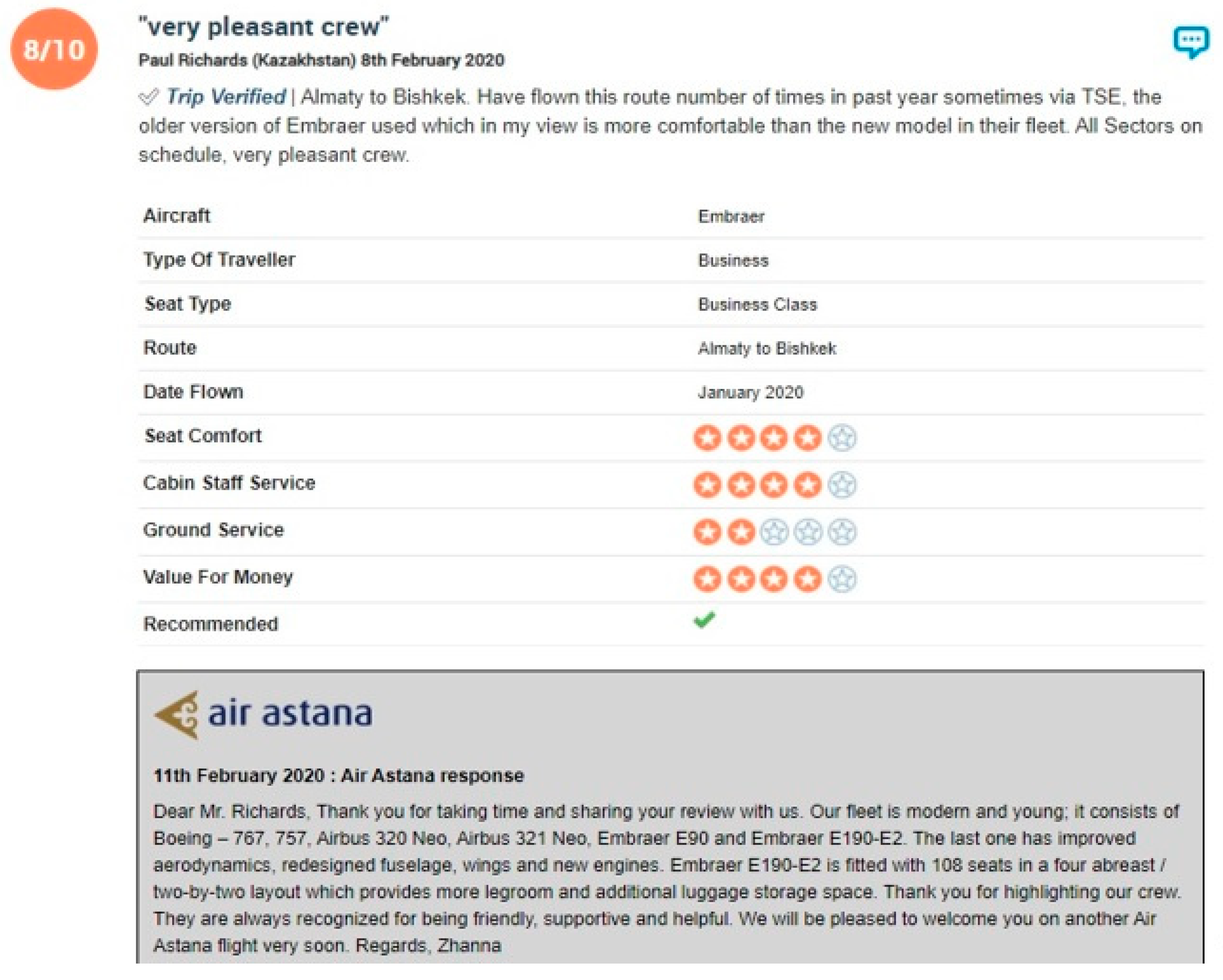
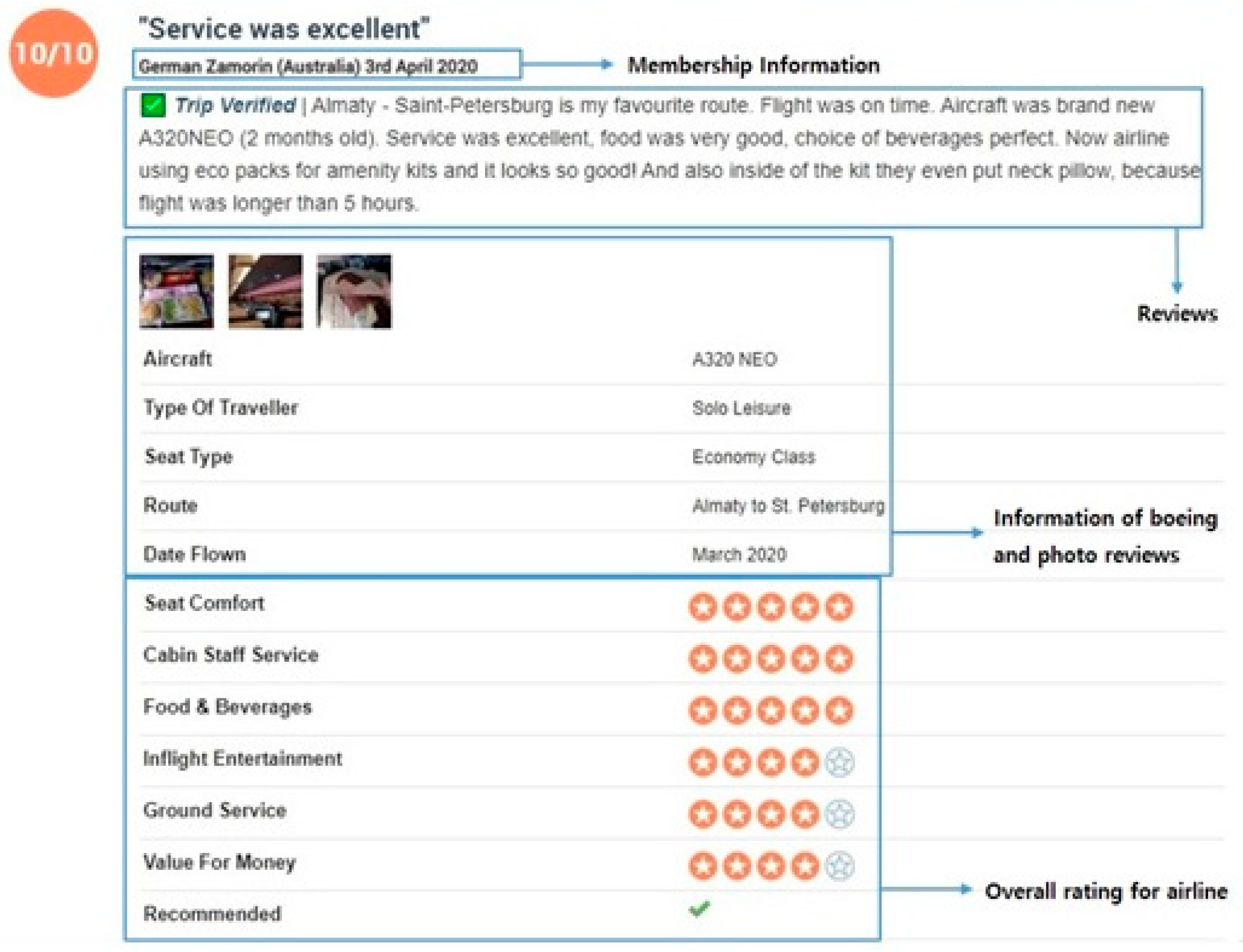
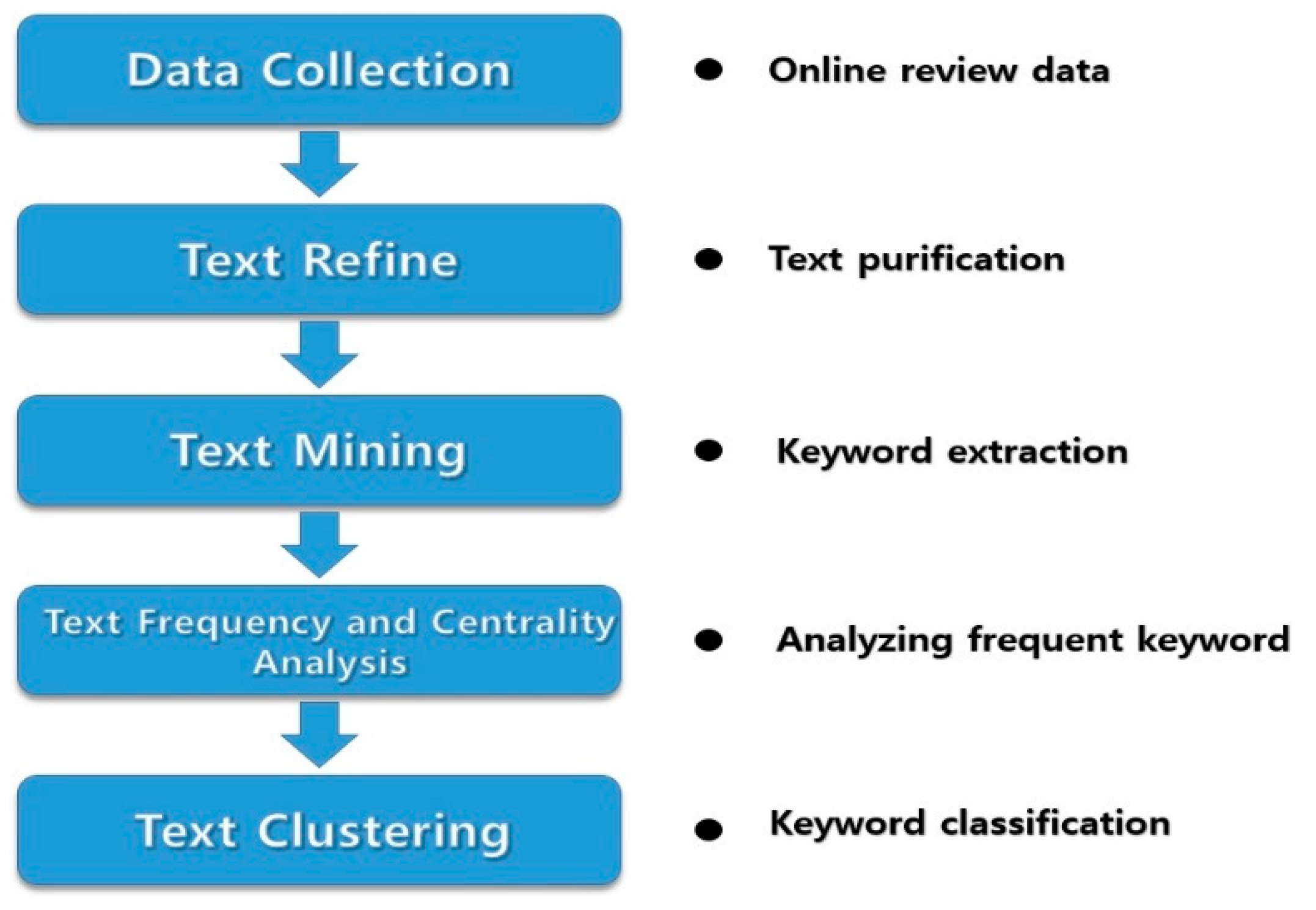
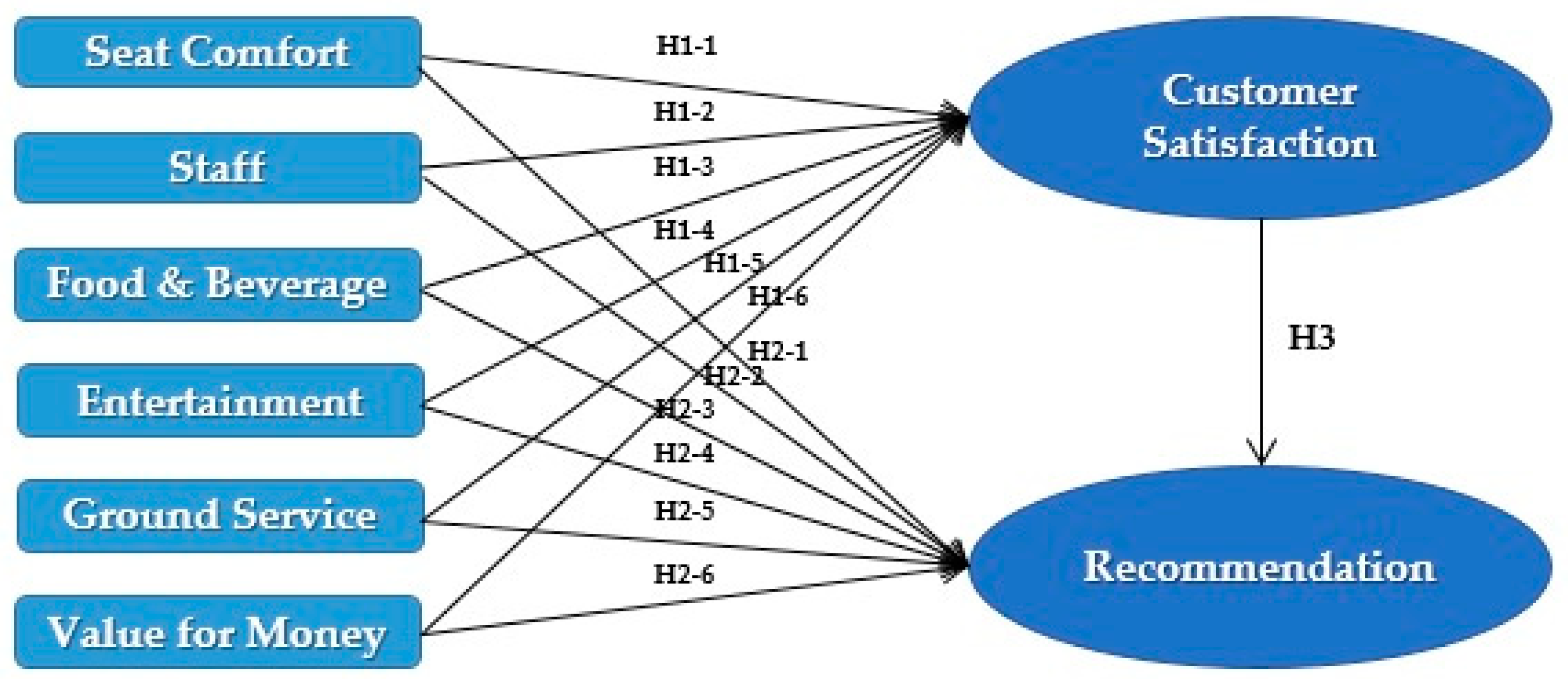
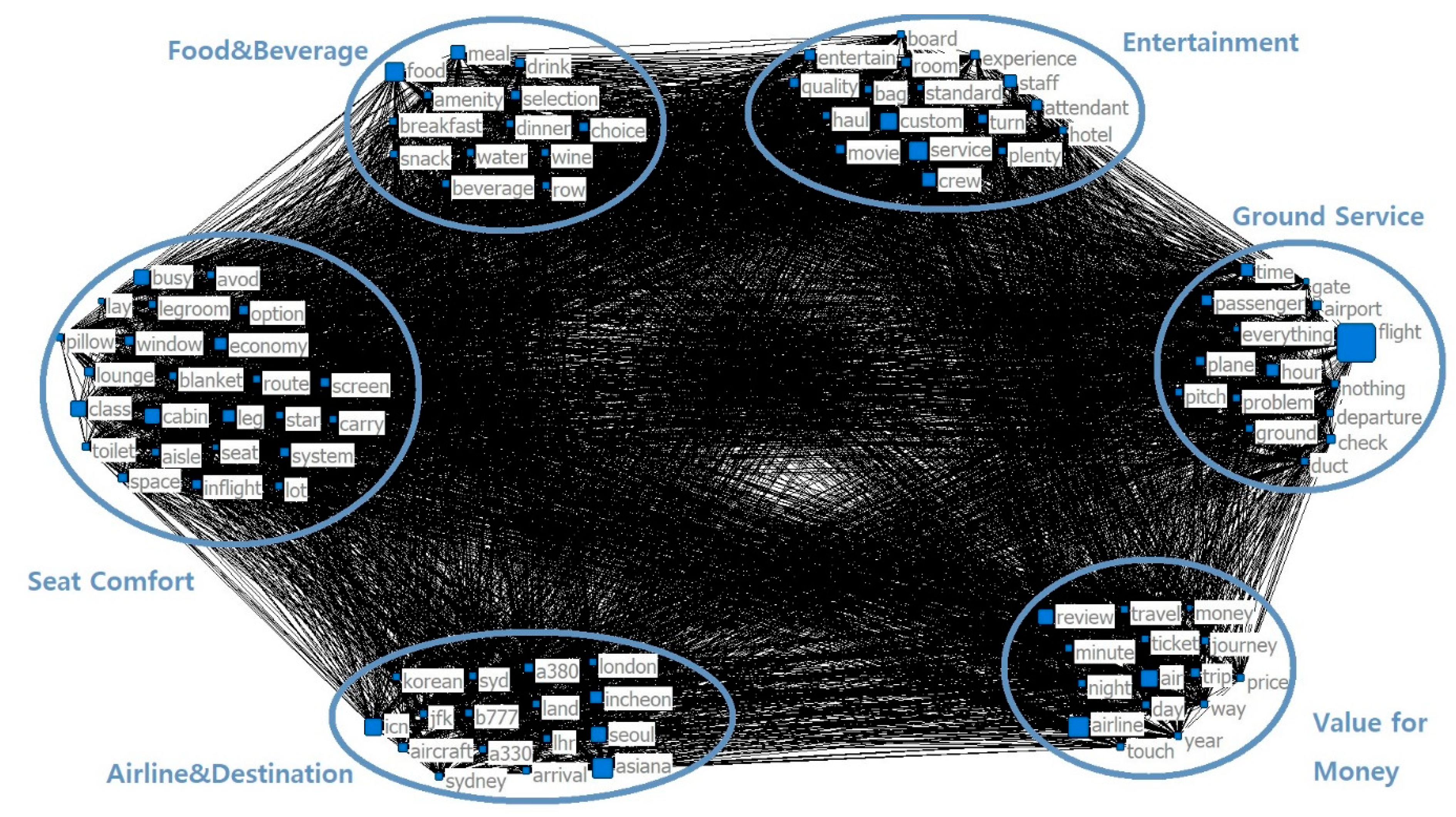
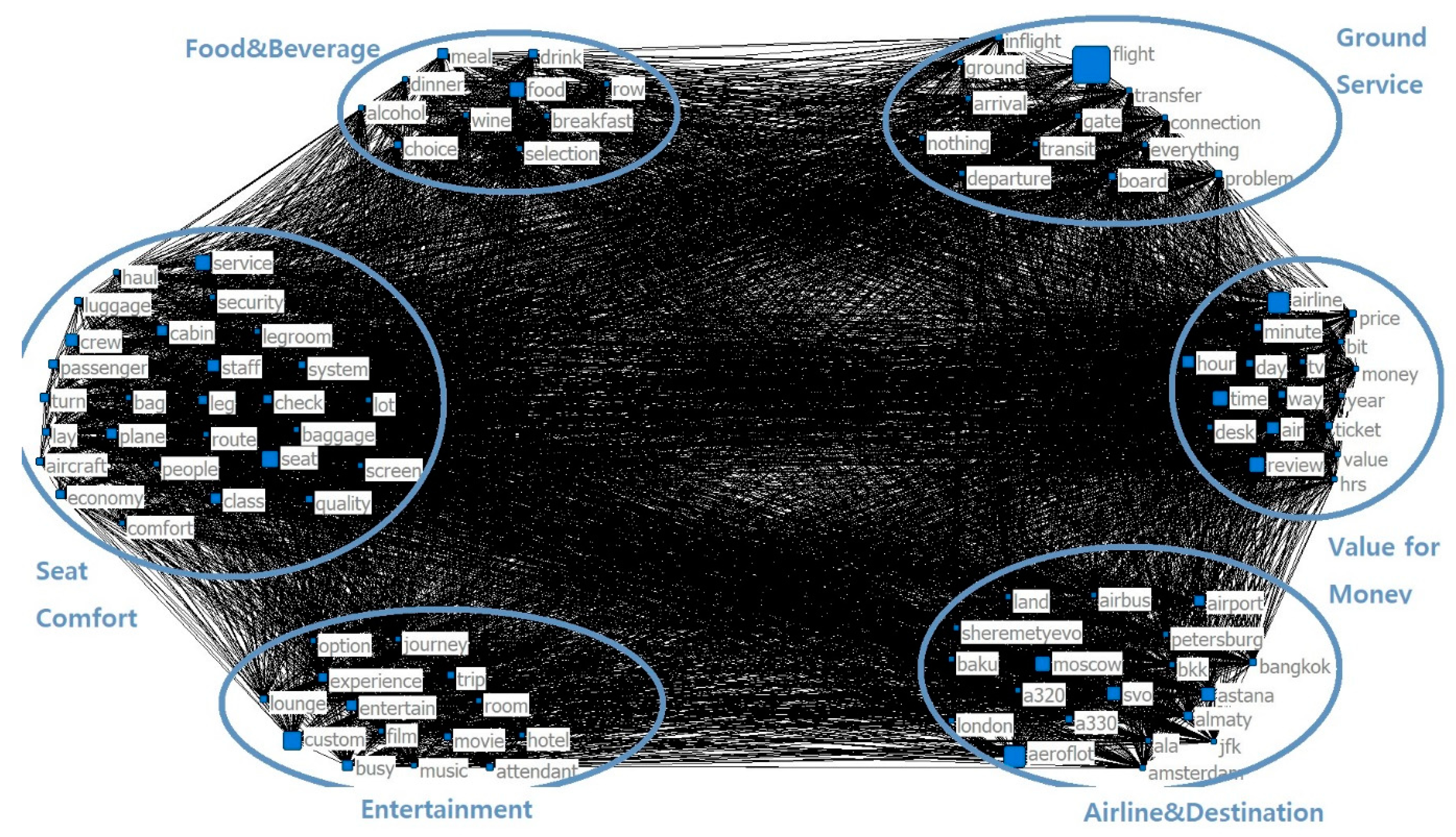
| Year | Researcher | Title | Finding |
|---|---|---|---|
| 2020 | Hausladen and Schosser [11] | Towards a maturity model for big data analytics in airline network planning | Developed a maturity model for big data readiness for airline network planning. |
| 2019 | Knorr [9] | Big data, customer relationship and revenue management in the airline industry: what future role for frequent flyer programs? | Provides a better understanding of airline industry and focused on linking access to advertised frequent programs through the big data analysis. |
| 2019 | Brochado, Rita, Oliveira Christina, and Oliveira Fernando [12] | Airline passengers’ perceptions of service quality: themes in online reviews | Identified the main themes shared in online reviews by airline travelers as well as which of these themes were linked with higher and lower value for money rankings. |
| 2013 | Namukasa [10] | The influence of airline service quality on passenger satisfaction and loyalty: the case of Uganda airline industry | Preflight, inflight, and postflight services had a significant effect on passengers’ satisfaction. In addition, mediating variables also had a significant effect on passenger loyalty. |
| 2011 | Pérezgonzález and Gilbey [13] | Predicting Skytrax airport rankings from customer reviews | Helps to explore the possibility of using customers’ reviews to predict Skytrax scores. |
| Author | Year | Title |
|---|---|---|
| Song, C., Guo, J., Zhuang, J. [17] | 2020 | Analyzing passengers’ emotions following flight delays—a 2011–2019 case study on SKYTRAX comments |
| Adeniran, A., Fadare, S.O. [18] | 2018 | Relationship between passengers’ satisfaction and service quality in Murtala Muhammed international airport, Lagos, Nigeria |
| Jeong, E.Y. [19] | 2017 | Analysis of airlines online reviews: focusing on Skytrax |
| Yayla-Kullu, H.M., Tansitpong, P. [20] | 2013 | A critical evaluation of US airlines’ service quality performance: lower costs compared to satisfied customers |
| Pérezgonzález, J.D., Gilbey, A. [13] | 2011 | Predicting Skytrax airport rankings from customer reviews |
| Lohmann, G., Albers, S., Koch, B., Pavlovich, K. [21] | 2009 | From hub to tourist destination—An explorative study of Singapore and Dubai’s aviation-based transformation |
| Mason, K.J., Morrison, W.G. [22] | 2008 | Towards a means of consistently comparing airline business models with an application to the ‘low cost’ airline sector |
| Park, J. W., Robertson, R., Wu, C.L. [23] | 2006 | The effects of individual dimensions of airline service quality: Findings from Australian domestic air passengers |
| Gillen, D., Lall, A. [24] | 2004 | Competitive advantage of low-cost carriers: some implications for airports |
| Rank in Skytrax | Brands | Reviews | Number of Stars | Customer Satisfaction |
|---|---|---|---|---|
| 23/100 | Aeroflot | 490 | 4 | 6.72 |
| 24/100 | Asiana Airlines | 445 | 5 | 8.06 |
| 33/100 | Korean Air | 495 | 4 | 7.62 |
| 48/100 | Air Astana | 205 | 4 | 8.03 |
| 58/100 | Azerbaijan Airlines | 58 | 4 | 7.06 |
| Rank | Word | Freq | % | Rank | Word | Freq | % |
|---|---|---|---|---|---|---|---|
| 1 | flight | 1759 | 5.41% | 51 | legroom | 103 | 0.31% |
| 2 | seat | 1025 | 3.15% | 52 | year | 98 | 0.30% |
| 3 | airline | 858 | 2.64% | 53 | wine | 95 | 0.29% |
| 4 | air | 781 | 2.40% | 54 | lot | 94 | 0.29% |
| 5 | service | 739 | 2.27% | 55 | minute | 94 | 0.29% |
| 6 | custom | 733 | 2.25% | 56 | snack | 92 | 0.28% |
| 7 | Asiana | 710 | 2.18% | 57 | route | 89 | 0.27% |
| 8 | food | 653 | 2.01% | 58 | ticket | 89 | 0.27% |
| 9 | review | 624 | 1.92% | 59 | JFK | 88 | 0.27% |
| 10 | ICN | 622 | 1.91% | 60 | a330 | 85 | 0.26% |
| 11 | Seoul | 534 | 1.64% | 61 | star | 81 | 0.25% |
| 12 | cabin | 489 | 1.50% | 62 | AVOD | 79 | 0.24% |
| 13 | crew | 477 | 1.47% | 63 | space | 78 | 0.24% |
| 14 | time | 442 | 1.36% | 64 | water | 77 | 0.24% |
| 15 | class | 440 | 1.35% | 65 | nothing | 74 | 0.23% |
| 16 | meal | 418 | 1.28% | 66 | breakfast | 71 | 0.22% |
| 17 | staff | 410 | 1.26% | 67 | dinner | 71 | 0.22% |
| 18 | Incheon | 379 | 1.16% | 68 | problem | 70 | 0.21% |
| 19 | busy | 350 | 1.08% | 69 | haul | 69 | 0.21% |
| 20 | hour | 342 | 1.05% | 70 | window | 68 | 0.21% |
| 21 | leg | 324 | 0.99% | 71 | hotel | 67 | 0.21% |
| 22 | entertain | 310 | 0.95% | 72 | land | 65 | 0.20% |
| 23 | economy | 281 | 0.86% | 73 | departure | 65 | 0.20% |
| 24 | turn | 247 | 0.76% | 74 | amenity | 64 | 0.20% |
| 25 | attendant | 227 | 0.70% | 75 | London | 63 | 0.19% |
| 26 | check | 218 | 0.67% | 76 | pitch | 62 | 0.19% |
| 27 | experience | 217 | 0.67% | 77 | night | 62 | 0.19% |
| 28 | passenger | 216 | 0.66% | 78 | board | 62 | 0.19% |
| 29 | airport | 208 | 0.64% | 79 | plenty | 62 | 0.19% |
| 30 | plane | 203 | 0.62% | 80 | carry | 61 | 0.19% |
| 31 | choice | 199 | 0.61% | 81 | b777 | 60 | 0.18% |
| 32 | drink | 179 | 0.55% | 82 | touch | 60 | 0.18% |
| 33 | movie | 174 | 0.53% | 83 | price | 60 | 0.18% |
| 34 | aircraft | 173 | 0.53% | 84 | journey | 59 | 0.18% |
| 35 | trip | 160 | 0.49% | 85 | day | 57 | 0.17% |
| 36 | lounge | 155 | 0.48% | 86 | toilet | 56 | 0.17% |
| 37 | screen | 141 | 0.43% | 87 | row | 55 | 0.17% |
| 38 | option | 139 | 0.43% | 88 | beverage | 54 | 0.17% |
| 39 | room | 139 | 0.42% | 89 | gate | 54 | 0.17% |
| 40 | inflight | 134 | 0.41% | 90 | standard | 53 | 0.16% |
| 41 | selection | 133 | 0.41% | 91 | bag | 51 | 0.16% |
| 42 | system | 133 | 0.41% | 92 | lay | 49 | 0.15% |
| 43 | quality | 131 | 0.40% | 93 | blanket | 49 | 0.15% |
| 44 | Korean | 130 | 0.40% | 94 | duct | 48 | 0.15% |
| 45 | a380 | 129 | 0.39% | 95 | money | 48 | 0.15% |
| 46 | Sydney | 114 | 0.35% | 96 | arrival | 48 | 0.15% |
| 47 | ground | 110 | 0.34% | 97 | pillow | 48 | 0.15% |
| 48 | way | 110 | 0.34% | 98 | everything | 48 | 0.15% |
| 49 | SYD | 104 | 0.32% | 99 | aisle | 48 | 0.15% |
| 50 | LHR | 104 | 0.32% | 100 | travel | 48 | 0.15% |
| Rank | Word | Freq | % | Rank | Word | Freq | % |
|---|---|---|---|---|---|---|---|
| 1 | flight | 1574 | 5.84% | 51 | day | 83 | 0.31% |
| 2 | Aeroflot | 818 | 3.03% | 52 | a320 | 77 | 0.28% |
| 3 | airline | 792 | 2.94% | 53 | screen | 76 | 0.28% |
| 4 | custom | 622 | 2.31% | 54 | selection | 75 | 0.28% |
| 5 | seat | 590 | 2.19% | 55 | year | 73 | 0.27% |
| 6 | service | 537 | 1.99% | 56 | gate | 73 | 0.27% |
| 7 | review | 533 | 1.98% | 57 | transit | 72 | 0.27% |
| 8 | food | 521 | 1.93% | 58 | bit | 72 | 0.27% |
| 9 | Moscow | 503 | 1.87% | 59 | transfer | 71 | 0.26% |
| 10 | time | 468 | 1.74% | 60 | haul | 71 | 0.26% |
| 11 | SVO | 460 | 1.71% | 61 | airbus | 69 | 0.26% |
| 12 | Astana | 399 | 1.48% | 62 | room | 66 | 0.24% |
| 13 | crew | 382 | 1.42% | 63 | money | 63 | 0.23% |
| 14 | air | 354 | 1.31% | 64 | row | 62 | 0.23% |
| 15 | staff | 339 | 1.26% | 65 | lot | 61 | 0.23% |
| 16 | hour | 323 | 1.20% | 66 | people | 60 | 0.22% |
| 17 | plane | 303 | 1.12% | 67 | route | 58 | 0.21% |
| 18 | cabin | 302 | 1.12% | 68 | departure | 58 | 0.21% |
| 19 | meal | 297 | 1.10% | 69 | wine | 58 | 0.21% |
| 20 | entertain | 292 | 1.08% | 70 | JFK | 57 | 0.21% |
| 21 | class | 278 | 1.03% | 71 | value | 56 | 0.21% |
| 22 | busy | 260 | 0.96% | 72 | ground | 56 | 0.21% |
| 23 | airport | 240 | 0.89% | 73 | London | 56 | 0.21% |
| 24 | drink | 217 | 0.80% | 74 | option | 55 | 0.20% |
| 25 | passenger | 202 | 0.75% | 75 | legroom | 55 | 0.20% |
| 26 | check | 192 | 0.71% | 76 | everything | 54 | 0.20% |
| 27 | economy | 190 | 0.70% | 77 | security | 54 | 0.20% |
| 28 | experience | 168 | 0.62% | 78 | Baku | 53 | 0.20% |
| 29 | turn | 167 | 0.62% | 79 | film | 50 | 0.18% |
| 30 | leg | 165 | 0.61% | 80 | journey | 50 | 0.18% |
| 31 | Almaty | 160 | 0.59% | 81 | baggage | 50 | 0.18% |
| 32 | aircraft | 152 | 0.56% | 82 | land | 49 | 0.18% |
| 33 | inflight | 127 | 0.47% | 83 | connection | 49 | 0.18% |
| 34 | luggage | 124 | 0.46% | 84 | hrs | 48 | 0.18% |
| 35 | lounge | 122 | 0.45% | 85 | nothing | 48 | 0.18% |
| 36 | choice | 115 | 0.43% | 86 | arrival | 48 | 0.18% |
| 37 | price | 114 | 0.42% | 87 | Petersburg | 48 | 0.18% |
| 38 | way | 114 | 0.42% | 88 | bag | 48 | 0.18% |
| 39 | lay | 113 | 0.42% | 89 | alcohol | 47 | 0.17% |
| 40 | ticket | 105 | 0.39% | 90 | comfort | 47 | 0.17% |
| 41 | minute | 105 | 0.39% | 91 | Sheremetyevo | 46 | 0.17% |
| 42 | movie | 103 | 0.38% | 92 | breakfast | 46 | 0.17% |
| 43 | attendant | 99 | 0.37% | 93 | Amsterdam | 46 | 0.17% |
| 44 | problem | 95 | 0.35% | 94 | ala | 46 | 0.17% |
| 45 | board | 95 | 0.35% | 95 | desk | 45 | 0.17% |
| 46 | quality | 91 | 0.34% | 96 | music | 45 | 0.17% |
| 47 | system | 90 | 0.33% | 97 | hotel | 43 | 0.16% |
| 48 | trip | 90 | 0.33% | 98 | tv | 43 | 0.16% |
| 49 | Bangkok | 90 | 0.33% | 99 | dinner | 43 | 0.16% |
| 50 | a330 | 86 | 0.32% | 100 | BKK | 42 | 0.15% |
| Clusters | CIS Airlines | Korean Airlines |
|---|---|---|
| Seat Comfort | seat/staff/comfort/legroom/system/screen/ leg/lay/people/cabin/luggage/bag/row | busy/blanket/lot/aisle/space/window/ option/pillow/carry |
| Staff | flight/gate/passenger/everything/nothing/ transfer/value/departure/arrival/problem/ inflight/transit/ground/economy | duct/pitch/hour/plane/airport/time/ check/problem |
| Entertainment | airline/price/review/air/hrs/hour | money/ticket/time/trip/way/air/review/ tv/day/night/journey |
| Ground Service | meal/dinner/drink/food/row/alcohol/choice/selection/wine/breakfast | Meal/wine/food/drink/dinner/alcohol/ water/snack |
| Value for Money | option/journey/custom/lounge/entertain/ hotel/movie/experience | board/quality/standard/staff/plenty/ service/crew/haul/turn/journey/trip/film |
| Airline Brand | Sheremetyevo/Peterburg/Aeroflot/baku/ Moscow/Astana/Almaty/Amsterdam/ala/ bkk/svo/Bangkok | Korean/Inchoen/Seoul/Asiana/London/ icn/Sydney/syd/lhr/jfk/a380/b777/a330 |
| Model | Unstandardized Coefficient | Standardized Coefficient | t | Sig. | Collinearity Statistics | ||
|---|---|---|---|---|---|---|---|
| B | Std. Error | Beta | Tolerance | VIF | |||
| (Constant) | –1.872 | 0.266 | –7.052 | < 0.001 | |||
| Seat Comfort | 0.528 | 0.097 | 0.233 | 5.440 | < 0.001 | 0.334 | 2.990 |
| Staff | 0.418 | 0.103 | 0.184 | 4.036 | < 0.001 | 0.297 | 3.362 |
| Food & Beverage | 0.306 | 0.104 | 0.134 | 2.933 | 0.004 | 0.295 | 3.388 |
| Entertainment | 0.163 | 0.073 | 0.074 | 2.228 | 0.027 | 0.554 | 1.804 |
| Ground Service | 0.218 | 0.077 | 0.109 | 2.836 | 0.005 | 0.414 | 2.418 |
| Value for Money | 0.783 | 0.094 | 0.354 | 8.350 | < 0.001 | 0.343 | 2.919 |
| Model | Unstandardized Coefficient | Standardized Coefficient | t | Sig. | Collinearity Statistics | ||
|---|---|---|---|---|---|---|---|
| B | Std. Error | Beta | Tolerance | VIF | |||
| (Constant) | –2.604 | 0.230 | –11.322 | < 0.001 | |||
| Seat Comfort | 0.278 | 0.070 | 0.110 | 3.952 | < 0.001 | 0.489 | 2.047 |
| Staff | 0.451 | 0.073 | 0.184 | 6.214 | < 0.001 | 0.431 | 2.319 |
| Food & Beverage | 0.218 | 0.073 | 0.093 | 3.001 | 0.003 | 0.397 | 2.518 |
| Entertainment | 0.084 | 0.061 | 0.036 | 1.389 | 0.166 | 0.549 | 1.823 |
| Ground Service | 0.416 | 0.070 | 0.194 | 5.977 | < 0.001 | 0.358 | 2.792 |
| Value for Money | 1.054 | 0.081 | 0.469 | 12.953 | < 0.001 | 0.289 | 3.459 |
| Model | Unstandardized Coefficient | Standardized Coefficient | t | Sig. | Collinearity Statistics | ||
|---|---|---|---|---|---|---|---|
| B | Std. Error | Beta | Tolerance | VIF | |||
| (Constant) | –0.286 | 0.064 | –4.480 | < 0.001 | |||
| Seat Comfort | 0.060 | 0.023 | 0.191 | 2.565 | 0.011 | 0.334 | 2.990 |
| Staff | 0.021 | 0.025 | 0.065 | 0.828 | 0.409 | 0.297 | 3.362 |
| Food & Beverage | 0.047 | 0.025 | 0.147 | 1.857 | 0.065 | 0.295 | 3.388 |
| Entertainment | 0.002 | 0.018 | 0.008 | 0.136 | 0.892 | 0.554 | 1.804 |
| Ground Service | –0.026 | 0.018 | –0.095 | –1.420 | 0.157 | 0.414 | 2.418 |
| Value for Money | 0.173 | 0.023 | 0.566 | 7.687 | < 0.001 | 0.343 | 2.919 |
| Model | Unstandardized Coefficient | Standardized Coefficient | t | Sig. | Collinearity Statistics | ||
|---|---|---|---|---|---|---|---|
| B | Std. Error | Beta | Tolerance | VIF | |||
| (Constant) | –0.445 | 0.054 | –8.291 | < 0.001 | |||
| Seat Comfort | 0.017 | 0.016 | 0.047 | 1.044 | 0.297 | 0.489 | 2.047 |
| Staff | 0.082 | 0.017 | 0.234 | 4.843 | < 0.001 | 0.431 | 2.319 |
| Food & Beverage | 0.028 | 0.017 | 0.084 | 1.669 | 0.096 | 0.397 | 2.518 |
| Entertainment | –0.027 | 0.014 | –0.080 | –1.876 | 0.062 | 0.549 | 1.823 |
| Ground Service | 0.063 | 0.016 | –0.207 | 3.903 | < 0.001 | 0.358 | 2.792 |
| Value for Money | 0.141 | 0.019 | 0.438 | 7.423 | < 0.001 | 0.289 | 3.459 |
| Model | Unstandardized Coefficient | Standardized Coefficient | t | Sig. | |
|---|---|---|---|---|---|
| B | Std. Error | Beta | |||
| Constant | –0.145 | 0.026 | < 0.001 | ||
| Customer Satisfaction (CIS) | 0.119 | 0.002 | 0.772 | 49.251 | < 0.001 |
| Customer Satisfaction (Kor) | 0.123 | 0.003 | 0.785 | 38.617 | < 0.001 |
| F | Sig. | t | Korean Airlines | CIS Airlines | Mean Difference | Std. Error Difference | |
|---|---|---|---|---|---|---|---|
| Seat comfort | 5.937 | 0.015 | 4.320 | 3.98 ± 1.073 | 3.72 ± 1.119 | 0.26 ± 0.046 | 0.058 |
| Staff | 14.127 | 0.000 | 8.158 | 4.35 ± 1.084 | 3.85 ± 1.257 | 0.5 ± 0.173 | 0.062 |
| Food and beverage | 1.695 | 0.193 | 3.126 | 3.91 ± 1.152 | 3.71 ± 1.166 | 0.2 ± 0.014 | 0.062 |
| Entertainment | 8.945 | 0.003 | 2.315 | 3.65 ± 1.192 | 3.49 ± 1.301 | 0.16 ± 0.109 | 0.070 |
| Ground service | 4.570 | 0.033 | 1.779 | 3.83 ± 1.404 | 3.61 ± 1.473 | 0.22 ± 0.069 | 0.123 |
| Value for money | 9.873 | 0.002 | 3.647 | 4.07 ± 1.140 | 3.85 ± 1.279 | 0.22 ± 0.139 | 0.060 |
| Recommendation | 52.373 | 0.000 | 3.651 | 0.81 ± 0.395 | 0.75 ± 0.443 | 0.08 ± 0.048 | 0.020 |
| Rating | 10.059 | 0.002 | 5.623 | 7.83 ± 2.487 | 7.11 ± 2.717 | 0.72 ± 0.23 | 0.129 |
Publisher’s Note: MDPI stays neutral with regard to jurisdictional claims in published maps and institutional affiliations. |
© 2020 by the authors. Licensee MDPI, Basel, Switzerland. This article is an open access article distributed under the terms and conditions of the Creative Commons Attribution (CC BY) license (http://creativecommons.org/licenses/by/4.0/).
Share and Cite
Shadiyar, A.; Ban, H.-J.; Kim, H.-S. Extracting Key Drivers of Air Passenger’s Experience and Satisfaction through Online Review Analysis. Sustainability 2020, 12, 9188. https://doi.org/10.3390/su12219188
Shadiyar A, Ban H-J, Kim H-S. Extracting Key Drivers of Air Passenger’s Experience and Satisfaction through Online Review Analysis. Sustainability. 2020; 12(21):9188. https://doi.org/10.3390/su12219188
Chicago/Turabian StyleShadiyar, Aralbayeva, Hyun-Jeong Ban, and Hak-Seon Kim. 2020. "Extracting Key Drivers of Air Passenger’s Experience and Satisfaction through Online Review Analysis" Sustainability 12, no. 21: 9188. https://doi.org/10.3390/su12219188
APA StyleShadiyar, A., Ban, H.-J., & Kim, H.-S. (2020). Extracting Key Drivers of Air Passenger’s Experience and Satisfaction through Online Review Analysis. Sustainability, 12(21), 9188. https://doi.org/10.3390/su12219188







